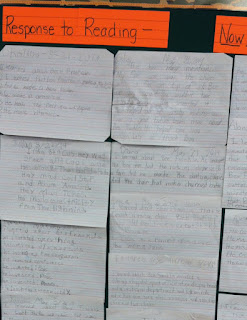Chapter 4: Creating Classroom Cultures that Support and Promote Student Thinking
Debbie Miller is still writing about environment in this chapter, but she has moved from the physical environment to the culture within the classroom. She writes that we must consider three things regarding creating this type of culture: putting our own thinking on display, using language intentionally, and making student thinking visible and public and permanent.
As teachers we must make our thinking more visible. We must show our own curiosity and interest in things in the world and in the things we read. We must show that we are open to alternate ideas. We can show that we are continuing to think about what we read or heard in class and that we even wonder if what we heard or read is true. We can show that we do further reading to find out if what we understand is right. Creating this type of culture is more than just doing a lot of different things or planning for specific "reflective" statements. We must be present, in the moment, and responding and reflecting in real time. That can be challenging but leads kids to do the same.
When engaging students in their thinking, we should intentionally choose our words to encourage more thinking. Questions or statements should show support and encourage further thinking and comment. Saying things like these can encourage and support students:
- Say more about that.
- This is what I think I heard you say. Do I have it right?
- I never thought about it like that before! Tell me more about what led you to think in this way.
- What do you think you should do next?
- What is another way to think about this?
- How did you figure this out?
We should also look for ways to make thinking more public and permanent. Write down what students say about topics; use their exact words. Post the thinking on anchor charts or quotes on the wall. Keep thinking visible for all students to encourage more and deeper thinking.
Several things that Debbie wrote in this chapter reminded me of my experiences in first and second grade. But the one that really triggered remembering and reflection was about thinking aloud. Thinking is largely invisible. "I think that thinking aloud about our thinking is he best way to make thinking visible," Debbie writes.
I remember reading about think alouds in my teacher's guide for reading instruction. I really did think it was silly and uncomfortable. But as I did it and thought about it, I also realized that kids don't know what I'm doing or what other readers are doing when reading. Instead of just telling them to think about they are reading or asking them what is confusing, I can show them. I can say, "I'm confused about this part. I'm not sure what is happening. I am going to read it again to see if I can understand what the character is doing."
Some kids are better at reflecting on what they are doing. Some are better at talking about their thinking. Some are quick to understand what's going on. Some don't know what they don't know.
Making thinking more visible, intentionally talking about thinking in ways that encourage more thinking, and displaying thinking publicly and permanently can create a place where kids will think and reflect and talk more about what they are reading and wondering. When thinking (or anything) is valued, it will be repeated.




